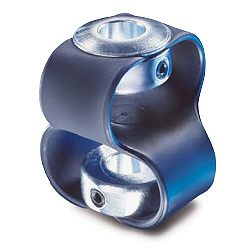Blog
All about K-Couplings
June 30, 2017
 Technical terms always cause a raised eyebrow while you try to decipher the term. K-Couplings are no exception, so let’s lay down a definition that explains this engineering term. Essentially, this shaft coupling is designed as a drive chain compensation mechanism. In other words, if there’s a misalignment error between two powered shafts, a flexible K-coupling correct will correct the problem. With that said, what does one of these devices look like?
Technical terms always cause a raised eyebrow while you try to decipher the term. K-Couplings are no exception, so let’s lay down a definition that explains this engineering term. Essentially, this shaft coupling is designed as a drive chain compensation mechanism. In other words, if there’s a misalignment error between two powered shafts, a flexible K-coupling correct will correct the problem. With that said, what does one of these devices look like?
Designing K-Coupling Profiles
Two thick loops of polyurethane form the unibody product so that it absorbs shock radial forces. The elastomeric material is also fitted with a bookending pair of zinc-plated hubs, which function as shaft anchoring assemblies. In the looks department, the shaft coupler resembles a figure-of-eight rubberized device, with the two loops offset from each other by ninety degrees. Finally, on the end mount components, the hubs, there’s an inbuilt keying arrangement, a feature that adds either Allan screws or flattened shaft keyways to the mechanism’s build.
Their Alignment Correcting Role
In engineering terms, two gear or motor drive axles must be correctly aligned. If mechanical alignment is maintained, radial momentum is transmitted efficiently. Unfortunately, this theoretical ideal can’t always be achieved, not without an expensive overhaul, at any rate. This is a scenario where elastomeric couplers excel. Lateral alignment problems are solved by adhering to this flexible corrective solution, as are any angular deviation glitches. In other words, this shaft connecting device utilises its flexible urethane loops as a shaft offset correction mechanism.
Other K-Couplers Advantages
The base of one motor is fractionally higher than its companion pump shaft. Over in the corner of the plant room, another shaft is mounted on an imperceptibly canted pedestal. Although the two device assemblies are transmitting power, an invisible offset is placing a strain on the bearings and mount. Fortunately, the K-Coupling is compensating for any off-balance loading. That same arrangement is also acting as a vibration dampening or isolating service, which is a critically important feature when one section of the power train is discharging lots of mechanical noise. The polyurethane loops stop the vibrations, isolate the noise, and quiet the system.
Ultimately, K-Couplings are employed as vibration and positional compensators in a drive chain. They continually adjust, even when an angular misalignment issue is severe. Thrust loads or angular errors, lateral alignment problems or vibration-prone drive trains, all of these problems are correctable when a twin-looped elastomeric K-Coupling is installed between two shafts.
Optimized by: Netwizard SEO

